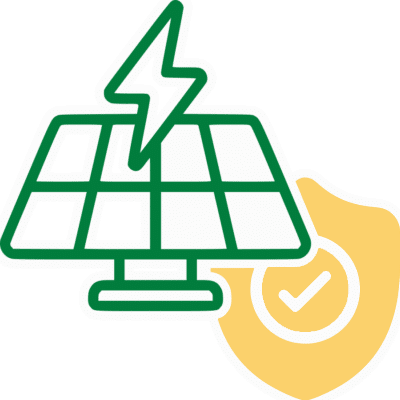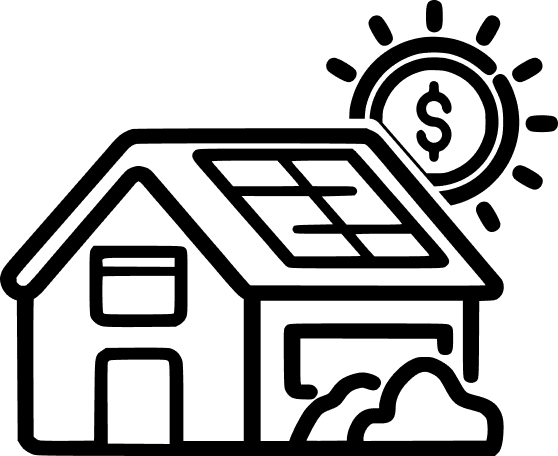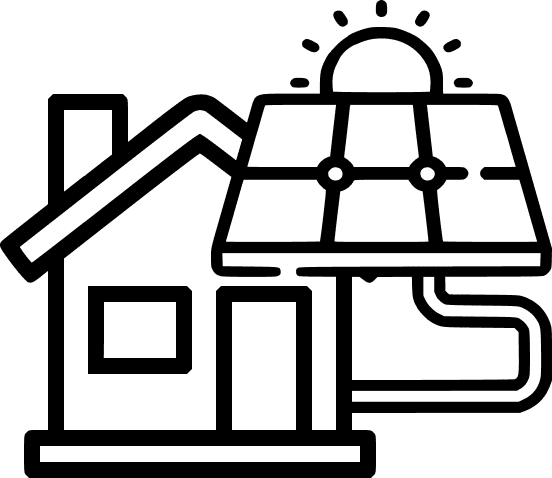
The patented technology used in our solar panels ensures maximised efficiency – even in low light – which means greater savings for our clients year round.

Research shows consumers are 100 times more likely to return a standard panel over a SunPower Panel, a testament to their quality.

The most comprehensive warranties available on the Australian market, with a full 40 Year Warranty and no hidden fine print.
Solar Systems
Slash Your Energy Costs with High-Performance 10kW Solar Systems Adelaide
With 30 high-performance solar panels and advanced inverter technology, a 10kW system ensures optimal energy production and efficiency.
With over 2500+ installations, we offer a broad range of products such as panels, inverters, batteries, EV chargers and energy storage systems. We are a proud supplier of SunPower panels – both Maxeon and SunPower Performance series, with a 40-year warranty.
Our expert team in Adelaide will handle the installation seamlessly, ensuring a hassle-free experience.
Take control of your energy future and contribute to a sustainable tomorrow by contacting us today to unlock the benefits of a 10kW solar system in Adelaide.
Upgrade to sustainable energy with our comprehensive solar panel packages, tailored for efficiency and cost savings.
How do you know if 10kW system is enough?
If you consume around 40-45 kWh per day, then 10kW system will fit your energy requirements. The average energy consumption in Australia is 40 Kwh per day for a household of 5+ people.
To determine if a 10kW system is sufficient for your home or business, consider the following steps:
- Assess Your Daily and Monthly Energy Consumption: Review your electricity bills to understand your average daily and monthly energy consumption.
- Calculate Your Energy Potential: Consider your location, roof orientation, and shading issues. Assess the potential of your property by determining the amount of sunlight you receive throughout the year.
- Estimate System Output: Compare this estimate with your average daily energy consumption to gauge if it can cover a significant portion of your energy needs.
- Consider Daytime Energy Usage: Take into account the timing of your energy consumption. A 10kW system primarily generates electricity during daylight hours. If you consume most of your energy during the day, it is more likely to meet a larger portion of your needs.
- Assess Future Energy Requirements: Consider any changes in your energy consumption, such as adding new appliances, electric vehicles, or expanding your living space.
- Consult a Professional: Reach out to a reputable provider who can assess your specific circumstances. They can perform an energy audit, analyze your energy consumption, and recommend the appropriate system size based on your needs, budget, and available roof space.
By considering these factors and seeking expert advice, you can determine if a 10kW system is sufficient for your home or business. Keep in mind that individual energy needs and circumstances may vary, and it’s best to consult with professionals who can provide personalized recommendations based on your unique situation.
Selecting the right system size depends on your budget, available roof space, electricity use and future energy plans.

How much space will 10kW system take?
The space required for a 10kW solar system depends on the type of panels used and the layout of the installation. Here are some general considerations:
- Roof Space: On average, a 10kW system may require approximately 60-100 square meters of roof space. This estimate can vary based on the specific dimensions and wattage of the panels used.
- Panel Efficiency: Higher efficiency panels can generate more power in a smaller area, allowing you to achieve a 10kW system with fewer panels and potentially requiring less overall space. Generally, this system may consist of approximately 30- 40 panels.
It’s important to consult with a professional who can assess your specific site and provide accurate information regarding the space requirements for a 10kW system. They can evaluate your roof or available land, consider factors such as shading, orientation, and local regulations, and design an optimal layout for maximum energy production within the available space.
Understanding your 10kW system options
When it comes to the best types of 10kW solar systems in Adelaide, there are a few factors to consider:
Monocrystalline Solar Panels
These panels are known for their high efficiency and sleek black appearance. They perform well in Adelaide’s sunny climate and offer good energy production.
Monocrystalline panels are perfect for residential, commercial, and off-grid properties where high efficiency and limited space are important factors.
Tier-1 Panels
Opt for panels from reputable manufacturers with Tier-1 certification. These panels are tested for quality, reliability, and performance, ensuring long-lasting efficiency and warranty support.
String Inverters or Microinverters
String inverters are cost-effective and suitable for most installations. However, if you have shading issues or want to optimise energy production, microinverters can be a better choice as they work on an individual panel level.
Monitoring and Smart Features
Look for systems that come with monitoring capabilities, allowing you to track your energy production and consumption. Smart features like online monitoring portals or mobile apps can provide real-time data for better control and management.
Expert Installation and Warranty
Ensure the solar system is installed by experienced professionals who understand local regulations and best practices. Also, check for comprehensive warranties on both panels and inverters.
What factors affect a 10kW solar system cost?
The cost can vary depending on several factors, including the quality of components, installation complexity, and additional features.
Additionally, government incentives such as the Solar Rebate Scheme or feed-in tariffs may help reduce the overall cost and improve the financial viability of installing the system.
Energy Buster Tip: Consider the long-term benefits, such as energy savings and potential increases in property value when evaluating the cost-effectiveness of your own 10kW solar system.
10kW system benefits
✔ Significant Energy Savings: A 10kW solar system can generate a substantial amount of electricity, offsetting a significant portion of your energy consumption. This can result in reduced electricity bills and long-term savings on your energy expenses.
✔ Environmental Sustainability: Renewable energy is clean and renewable, helping to reduce greenhouse gas emissions and combat climate change. By installing a 10kW system, you contribute to a cleaner and greener future by generating electricity from a sustainable source.
✔ Return on Investment: Investing in a 10kW system can provide a favourable return on investment over time. With potential energy savings, government incentives, and feed-in tariffs, you can recoup your initial investment and start enjoying the financial benefits of renewable energy.
✔ Increased Property Value: The installations are seen as valuable upgrades to properties. A 10kW system can enhance the market appeal and value of your home or business in Adelaide, attracting environmentally-conscious buyers and potentially yielding higher resale value.
✔ Energy Independence: Generating your own electricity with a 10kW system reduces your reliance on the grid. This can provide a sense of energy independence and protection against rising electricity costs or power outages.
✔ Government Incentives: Adelaide residents may be eligible for various government incentives, such as rebates, feed-in tariffs, or low-interest financing options, making the installation of a 10kW system more affordable and financially attractive.
What is the installation process for a 10kW system?
The installation process for a 10kW system typically involves the following steps:
Step One: Consultation and Assessment
The provider will conduct an initial consultation to assess your energy needs, evaluate your property’s potential, and discuss your specific requirements and goals.
Step Two: System Design and Proposal
Based on the assessment, the provider will design a custom 10kW system for your Adelaide property. They will provide a detailed proposal outlining the system components, layout, expected energy production, and cost.
Step Three: Financing and Paperwork
If necessary, you can explore financing options and complete any required paperwork or documentation, including government rebate applications and grid connection agreements.
Step Four: Installation Scheduling
Once the proposal is accepted, the provider will schedule a convenient installation date. They will consider factors like weather conditions, accessibility, and any necessary permits.
Step Five: Mounting and Panel Installation
On the scheduled day, the installation team will arrive at your property and begin mounting the panels on your roof or ground-mounted racks. They will ensure the panels are securely installed and positioned for maximum sunlight exposure.
Step Six: Electrical Wiring and Inverter Installation
The installers will connect the panels to an inverter, which converts the DC power generated by the panels into usable AC power. They will also connect the inverter to your property’s electrical system, usually in the meter box.
Step Seven: Electrical Safety and Grid Connection
A qualified electrician will perform necessary safety checks, such as isolating the system from the grid during installation. Once everything is verified, they will connect the system to the electricity grid, allowing excess energy to be fed back to the grid if applicable.
Step Eight: System Testing and Commissioning
The installation team will conduct thorough testing to ensure the system is functioning correctly and efficiently. They will also provide instructions on system monitoring and usage.
Step Nine: Final Documentation and Handover
The provider will provide you with all relevant documentation, including warranties, user manuals, and instructions for system maintenance. They will also address any final questions or concerns you may have.
If you think that purchasing panels is the right thing for you, then the next step is to decide on the best brand and system size. Get in touch with us by either calling us on (08) 7120 6377 or by filling out our fast free quote form.
























































